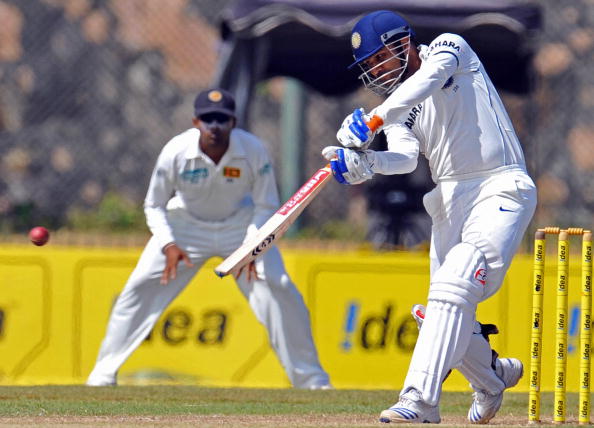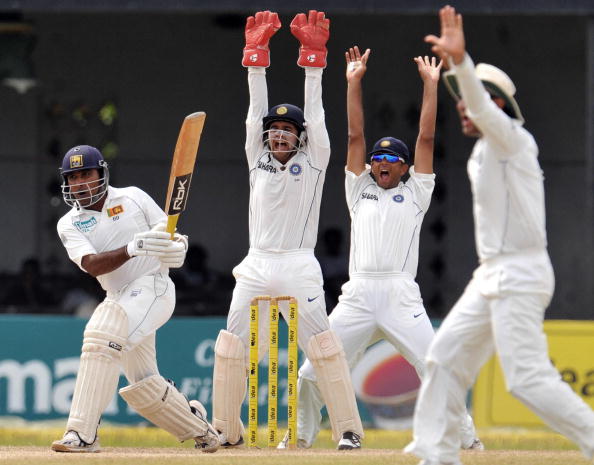
SK Flashback: DRS and Ajantha Mendis leave India in tatters in the 2008 Test series

The Test series between India and Sri Lanka in 2008 saw the introduction of Ajantha Mendis’s mystery spin and the DRS system in international cricket. Indian batsmen had no answer to the mystery spin while the DRS system turned out to be a nightmare for Anil Kumble and Co.
Under Kumble’s leadership, India arrived in Sri Lanka to play three Tests in July 2008 with a strong squad that included the big four batsmen and a solid bowling line-up. Equally well balanced were the hosts who had the home advantage.
Ist Test: India’s horrible start to the series
In the first Test, India were outplayed, outclassed and completely destroyed by Sri Lanka. Riding on four centuries, the hosts posted a massive total of 600 in the first innings. Malinda Warnapura, Mahela Jayawardene, Thilan Samaraweera and Tillakaratne Dilshan smashed individual hundreds to tear apart the Indian bowling.
When India came to bat, the pitch suddenly became a minefield and the red cherry started misbehaving. Whether it was the pressure of 600 runs or it was the fear of facing Mendis, Indian batsmen looked vulnerable, helpless and out of ideas.
Muralitharan exploited India’s uneasiness and wrecked their batting line-up as India managed 223 runs in the first innings and while following-on, they hit another low and were dismantled for only 138 runs.
India lost the match by an innings and 239 runs, one of their biggest ever defeats in Test cricket. Muralitharan picked up 11 wickets in the game while the debutant Mendis grabbed eight scalps.
2nd Test: Sehwag’s scintillating double-hundred lifts India

After a horrific performance in the first Test, very few expected India to bounce back but Kumble’s men showed their class and turned the tables in the next game. The redemption began with Virender Sehwag producing one of the finest knocks in Test cricket.
On a pitch that turned dangerously and was further deteriorated by frequent rains, Sehwag scored 201 runs off just 231 balls. The next highest score in the innings was 56 by Gautam Gambhir and only one other batsman reached double figures. India scored 329 runs out of which 201 came from Sehwag’s bat.
Extra cover: SK Elite: Virender Sehwag's 201 not out against Sri Lanka at Galle
Kumble and Harbhajan then responded brilliantly by making use of the spinning track and restricted the hosts to 292. The duo of Gambhir and Sehwag scored fifties in the second innings as well and in the fourth innings, Sri Lanka was bowled out for 136 runs, with India winning the game by 170 runs.
Mendis’s ten wicket haul in the match was impressive but the highlight of the Test was Sehwag who with his courageous approach and unbelievable clarity of mind crafted an innings that was invaluable.
3rd Test: Mendis and DRS help Sri Lanka to win the series
The series took another turn in the final Test as the hosts upped the ante at the crucial moments. Kumar Sangakkara’s masterpiece of 144 runs earned the hosts a decisive lead of 147 runs in the first innings. The spin duo of Mendis and Murli once again tormented the Indian batsmen and the hosts wrapped up the series by chasing 122 runs with ease in the fourth innings.
Murali accumulated 21 scalps in the series but was overshadowed by Mendis who finished with 26 wickets, a record for a debutant. The series boasted the enigma surrounding Mendis’ spin bowling and also proved to be the final nail in the coffin in Sourav Ganguly and Anil Kumble’s Test careers as both hung their boots in following series.
In terms of cricketing skills, the hosts were miles ahead of the visitors but in the use of DRS, they were simply too good. It was the first time DRS was used in Test cricket and India offered a perfect manual of how not to use the technology.
India’s woes against DRS

In the first Test, Harbhajan Singh used the DRS against Warnapura but it was turned down. India used two more reviews in the Test and both were turned down. Things became worse in the second Test as only one out of seven reviews taken by India was upheld. It was Ganguly who got it right when he took a review as the on-field umpire ruled him out leg-before on Murali’s bowling.
In the final Test, all ten reviews taken by India were turned down. Over-excitement and the inability to read the situation with clarity were responsible for India’s pathetic use of DRS but they were also done in by some gaping holes that existed in the technology.
The flaws in DRS became evident when Kumble’s appeal for LBW against Samaraweera in the final Test was turned down by the on-field umpire as well as the DRS review. Bowling over the wicket, one of Kumble’s deliveries didn’t turn and went in with the angle. The ball crashed on Samaraweera’s pad after missing his bat.
Sensing a possibility of an inside edge and the chance of the ball bouncing above the stump, the on-field umpire rejected Kumble’s shout for leg before. The Indian captain promptly sought help from the technology but the third umpire too failed to rectify the mistake.
Extra cover: Top 5 wicket-takers in Tests between India and Sri Lanka
At that time, in the DRS, the third umpire could only see the pitching of the ball and its impact. Although the technology that predicted the path of the ball was available it wasn’t used in the DRS due to doubts over its accuracy.
Billy Doctrove, the third umpire for the match, studied the pitching and impact of the ball and concluded that it would miss the stumps. However, when the Virtual Eye technology later predicted the path of the ball it was clear that the ball would have taken a major chunk of the middle stump.
It was a blunder which made revealed the results of human mistakes and also the limited use of technology. Unfortunately for India, throughout the series, they were on the receiving end of this technology.